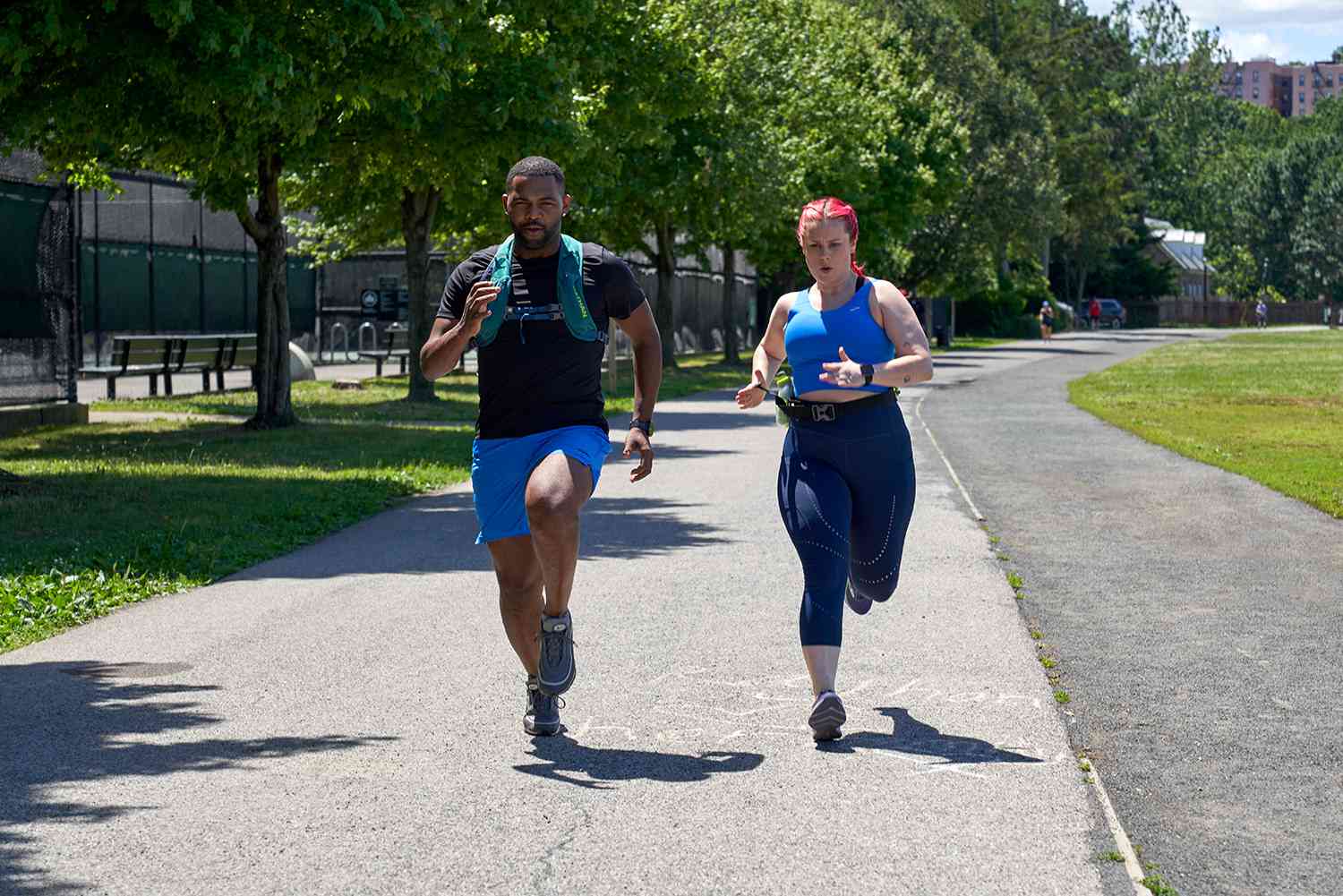

Featured
What Type Of Exercise Is Jogging
Modified: August 21, 2023
Looking to get fit? Find out why jogging is a featured exercise that can help you improve your cardiovascular health and burn calories.
Introduction
Welcome to your guide to the wonderful world of jogging! Whether you’re a seasoned runner or a beginner looking to start a new fitness routine, jogging is a fantastic exercise that can provide numerous benefits for your body and mind. In this article, we will explore the various advantages of jogging and provide you with some tips to help you get started on this fulfilling journey.
Jogging is a form of aerobic exercise that involves running at a steady and moderate pace. It is a popular choice among fitness enthusiasts due to its accessibility and the numerous health benefits it offers. Whether you prefer to jog on the treadmill at the gym, on a track, or in the great outdoors, this simple yet effective exercise can make a significant impact on your overall well-being.
When it comes to physical fitness, jogging is a versatile exercise that can target multiple areas of your body. It can help improve cardiovascular health, aid in weight loss, enhance mental well-being, and strengthen your muscles and bones. Moreover, jogging doesn’t require any fancy equipment or expensive gym memberships, making it an accessible and affordable exercise option for people of all ages and fitness levels.
In the following sections, we will delve deeper into the specific benefits of jogging and provide you with practical tips to incorporate jogging into your fitness routine. Whether your goal is to boost your cardiovascular endurance, shed some extra pounds, or simply enjoy the mental clarity that comes with a good run, jogging might just be the key to achieving your fitness goals.
Benefits of Jogging
Jogging offers a wide range of benefits for both your physical and mental well-being. From improving cardiovascular health to aiding in weight loss and reducing stress, here are some of the many advantages of incorporating jogging into your fitness routine:
- Cardiovascular Benefits: Jogging is an excellent cardiovascular exercise that can help improve the health of your heart and lungs. Regular jogging increases your heart rate, improving blood circulation, and strengthening your cardiovascular system. This, in turn, can reduce the risk of heart disease, stroke, and high blood pressure.
- Weight Loss Benefits: Jogging is a highly effective exercise for weight loss. Running at a moderate pace can help burn calories and fat, making it an ideal activity for those looking to shed some extra pounds. Additionally, jogging boosts your metabolism, allowing you to continue burning calories even after your workout.
- Mental Health Benefits: Jogging provides significant mental health benefits by reducing stress, anxiety, and depression. Regular exercise stimulates the release of endorphins, also known as “feel-good” hormones, which can enhance your mood and promote a sense of well-being. Jogging outdoors also allows you to connect with nature and provides a form of active meditation.
- Musculoskeletal Benefits: Jogging is a weight-bearing exercise that strengthens your muscles and bones, improving overall musculoskeletal health. It can help increase bone density, reducing the risk of osteoporosis, and strengthen your leg muscles, including your quadriceps, hamstrings, and calves. Regular jogging also enhances joint flexibility and stability.
Jogging not only provides physical benefits but also has a positive impact on mental clarity and focus. It can help boost your energy levels, improve sleep quality, and enhance cognitive function. Additionally, the sense of accomplishment and self-confidence that comes from setting and achieving jogging goals can boost your overall well-being.
Incorporating jogging into your routine doesn’t have to be daunting. Begin by setting small, attainable goals and gradually increase your distance and pace. Remember to listen to your body and take rest days to prevent overexertion or injury. Additionally, proper warm-up and cool-down exercises, as well as wearing appropriate footwear and clothing, can help ensure a safe and enjoyable jogging experience.
Now that we’ve explored the numerous benefits of jogging, let’s dive into the specifics of how you can get started with this invigorating exercise.
Cardiovascular Benefits of Jogging
Jogging is an excellent aerobic exercise that offers a multitude of cardiovascular benefits. When you engage in regular jogging, your heart and lungs work harder, leading to improvements in your overall cardiovascular health. Let’s take a closer look at the specific benefits that jogging can provide for your heart and circulatory system:
- Improved Heart Health: Jogging is a powerful workout that strengthens your heart muscles. By consistently challenging your cardiovascular system, jogging helps to increase your heart rate, improving blood flow throughout your body, and enhancing the efficiency of your heart. Over time, this can reduce the risk of heart disease, heart attacks, and strokes.
- Lowered Blood Pressure: Regular jogging can also help lower blood pressure levels. As your heart becomes stronger and more efficient, it pumps blood more effectively, reducing the strain on your arteries and resulting in decreased blood pressure. This lowering of blood pressure can have a significant impact on your overall health and reduce the risk of hypertension.
- Enhanced Blood Circulation: Jogging stimulates blood circulation, allowing oxygen-rich blood to be efficiently transported to your muscles, organs, and tissues. This increased blood flow supplies your body with essential nutrients and oxygen, promoting cell growth and overall vitality. Improved circulation can also improve endurance and boost your energy levels.
- Increased Stamina and Endurance: Regular jogging helps to improve your cardiovascular fitness, leading to increased stamina and endurance. As you push your body during jogging sessions, your heart adapts by becoming more efficient at delivering oxygen to your muscles. This improved stamina not only benefits your workouts but also carries over to your everyday activities.
Engaging in moderate-intensity aerobic activity like jogging for at least 150 minutes per week (as recommended by the World Health Organization) can significantly contribute to these cardiovascular benefits. It is important to start at a pace and distance that is comfortable for you and gradually increase the intensity and duration of your jogging sessions.
Remember, consistency is key in reaping the cardiovascular benefits of jogging. Aim to make jogging a regular part of your exercise routine to experience long-term improvements in your heart health and overall cardiovascular fitness.
Now that we’ve explored how jogging can benefit your cardiovascular system, let’s move on to the weight loss benefits that this exercise can offer.
Weight Loss Benefits of Jogging
Jogging is an effective exercise for weight loss and can help you shed those extra pounds. Whether you’re looking to slim down, maintain a healthy weight, or simply improve your overall body composition, incorporating jogging into your fitness routine can provide significant weight loss benefits. Here’s how jogging can help you on your weight loss journey:
- Calorie Burning: Jogging is a high-impact cardiovascular exercise that burns a significant amount of calories. The number of calories burned during a jog depends on factors such as your weight, pace, and duration of the workout. On average, a 155-pound person can burn approximately 372 calories by jogging for 30 minutes at a moderate pace. Increasing the intensity or duration of your jogging sessions can further enhance calorie burn.
- Fat Burning: Jogging is a great way to target and reduce body fat. When you engage in aerobic activities like jogging, your body utilizes stored fat as a source of energy. Regular jogging gradually depletes fat stores, resulting in reduced body fat percentage and improved body composition. Combining jogging with strength training exercises can further enhance fat burning and promote lean muscle development.
- Increase in Metabolism: Regular jogging boosts your metabolism, which is the rate at which your body burns calories at rest. This enhanced resting metabolic rate can help you burn calories even when you’re not exercising. The increase in metabolism is a result of your body’s adaptation to the demands of jogging, which requires more energy and results in a higher calorie burn throughout the day.
- Appetite Regulation: Jogging can also help regulate appetite and control cravings. After a jog, your body releases hormones that suppress hunger and promote satiety. This can help you make healthier food choices and reduce your overall caloric intake, further aiding in weight loss.
While jogging can be an effective tool for weight loss, it’s important to remember that achieving and maintaining a healthy weight involves a combination of regular exercise and a balanced diet. Pairing your jogging routine with a nutritious and calorie-controlled eating plan will optimize the weight loss benefits and ensure sustainable results.
When starting a jogging routine for weight loss, it’s recommended to start gradually and listen to your body. Begin with shorter distances and slower paces, then gradually increase the intensity and duration of your jogs as you build endurance. Consistency is key in achieving weight loss goals, so aim to make jogging a regular part of your fitness routine.
In the next section, we’ll explore the mental health benefits of jogging and how it can contribute to your overall well-being.
Mental Health Benefits of Jogging
In addition to its physical benefits, jogging offers numerous mental health benefits that can contribute to improved overall well-being. Engaging in regular jogging can have a positive impact on your mental state, emotions, and cognitive function. Here are some of the mental health benefits you can experience through jogging:
- Stress Reduction: Jogging is a powerful stress buster. When you jog, your body releases endorphins, which are natural chemicals that act as mood elevators. These endorphins help reduce stress levels and promote a sense of well-being. Jogging also provides an excellent opportunity to clear your mind, allowing you to escape from the daily stressors of life and find a sense of calm.
- Anxiety and Depression Management: Jogging has been shown to be effective in managing symptoms of anxiety and depression. It boosts the production of neurotransmitters like serotonin and norepinephrine, which are known to regulate mood and improve mental health. Regular jogging can help alleviate symptoms of anxiety and depression, leading to a more positive outlook on life.
- Improved Sleep Quality: Jogging can help improve the quality of your sleep. Engaging in physical activity like jogging increases the production of melatonin, a hormone that regulates sleep patterns. Jogging also helps to release any pent-up energy and tension, promoting a deeper and more restful sleep at night.
- Brain Function and Cognitive Enhancement: Jogging has been linked to improved brain function and cognitive abilities. Aerobic exercises like jogging increase blood flow to the brain, delivering oxygen and nutrients that support optimal brain performance. Regular jogging has been associated with enhanced memory, sharper focus, and improved overall cognitive function.
Jogging also provides an opportunity for introspection, self-reflection, and problem-solving. Going for a jog can give you the mental space and clarity to think through challenges, generate creative ideas, and gain a fresh perspective on life. It can be a time for self-care and self-discovery, allowing you to connect with yourself on a deeper level.
Whether you’re dealing with everyday stress, struggling with mental health concerns, or simply looking to boost your mood and cognitive abilities, incorporating jogging into your routine can have a profound impact on your mental well-being. Start by setting realistic goals, be consistent with your jogging routine, and be mindful of the positive effects it has on your mental health.
In the next section, we’ll discuss the musculoskeletal benefits of jogging and how it can strengthen your body.
Musculoskeletal Benefits of Jogging
Jogging not only improves cardiovascular fitness and mental well-being but also provides significant musculoskeletal benefits. This form of high-impact exercise helps strengthen your muscles and bones, enhancing your overall musculoskeletal health. Let’s explore the specific ways jogging can benefit your muscles and skeletal system:
- Stronger Leg Muscles: Jogging primarily targets the muscles in your legs, including the quadriceps, hamstrings, calves, and glutes. Regular jogging helps to strengthen and tone these muscles, leading to improved lower body strength and stability. Strong leg muscles also contribute to better balance and reduced risk of falls or injuries.
- Increased Bone Density: Jogging is a weight-bearing exercise that stimulates the production of new bone tissue, leading to increased bone density. This is particularly important for individuals at risk of osteoporosis, a condition characterized by weak and brittle bones. By consistently challenging your skeletal system, jogging can help improve bone strength and reduce the risk of fractures.
- Improved Joint Health: Contrary to popular belief, jogging can actually be beneficial for your joints when performed correctly. Regular jogging helps to strengthen the muscles around your joints, providing support and stability. Additionally, jogging stimulates the production of synovial fluid, which lubricates the joints and reduces friction, leading to improved joint health and flexibility.
- Enhanced Core Strength: Jogging engages your core muscles as they help stabilize your body during the movements. By consistently engaging your core while running, you can strengthen your abdominal muscles and lower back. This improves core stability and posture, reducing the risk of back pain and enhancing overall functional fitness.
It’s important to note that proper technique and gradual progression are key to reaping the musculoskeletal benefits of jogging while minimizing the risk of injuries. Begin with shorter distances and slower paces, allowing your muscles and bones to adapt gradually. As your fitness level improves, you can gradually increase the duration and intensity of your jogging sessions.
Additionally, it’s crucial to incorporate proper warm-up and cool-down exercises into your jogging routine. A dynamic warm-up that includes stretching and mobility exercises prepares your muscles and joints for the impact of jogging. Likewise, a cooldown routine with gentle stretches can help prevent muscle soreness and promote recovery.
By incorporating jogging into your fitness routine, you can strengthen your muscles, improve bone density, enhance joint health, and boost core strength. Enjoy the physical benefits that come with jogging while taking the necessary precautions to ensure a safe and effective workout.
In the next section, we’ll provide some practical tips to help you get started with jogging and incorporate it into your lifestyle.
How to Get Started with Jogging
If you’re ready to lace up your running shoes and embark on a jogging journey, here are some useful tips to help you get started:
- Start Slowly: If you’re new to jogging or have been inactive for a while, it’s important to start slowly. Begin with a combination of walking and jogging, gradually increasing the amount of time you spend jogging. This allows your body to adapt to the impact and intensity of running.
- Set Realistic Goals: Set achievable goals that align with your fitness level and lifestyle. Start with small milestones, such as running for a certain distance or time, and gradually work your way up. Celebrate your progress along the way, and don’t be too hard on yourself if you face setbacks.
- Choose the Right Footwear: Invest in a pair of well-fitting running shoes that provide proper cushioning and support for your feet. Visit a specialty running store to have your gait analyzed and receive guidance on the best shoe options for your specific foot type.
- Find a Running Route: Explore your local area to find a running route that suits your preferences. Whether it’s a nearby park, a trail, or even just around your neighborhood, having an enjoyable route can make your jogging experience more pleasant and motivating.
- Listen to Your Body: Pay attention to any discomfort or pain during your jogging sessions. If you experience sharp or recurring pain, it’s important to rest and seek medical advice if necessary. Don’t push through severe pain or disregard any warning signs from your body.
- Keep a Consistent Schedule: Make jogging a regular part of your routine by scheduling it into your calendar. Aim to jog at least three times a week, gradually increasing the frequency if desired. Consistency is key to reaping the benefits of jogging and improving your fitness.
- Find a Running Buddy or Join a Group: Jogging with a partner or joining a running group can provide motivation and accountability. Having someone to chat with or share your achievements and challenges can make the jogging experience more enjoyable and help you stay committed to your goals.
Remember, jogging is a personal journey, and it’s important to focus on your own progress rather than comparing yourself to others. Listen to your body, be patient with yourself, and celebrate each milestone along the way. With dedication and consistency, you’ll gradually build your endurance and improve your fitness level.
Now that you’re equipped with valuable tips for getting started, it’s time to explore the proper technique for jogging in the next section.
Proper Technique for Jogging
Having the correct technique while jogging is essential to maximize the benefits of this exercise and minimize the risk of injuries. Here are some tips to help you maintain proper form while jogging:
- Posture: Maintain an upright posture while jogging, with your head up, shoulders relaxed, and back straight. Avoid slouching or leaning too far forward or backward, as this can put undue strain on your muscles and increase the risk of injury.
- Arm Position: Bend your arms at a 90-degree angle and swing them naturally as you jog. Keep your elbows close to your body, and avoid excessive movement or crossing your arms in front of your chest. The motion of your arms will help maintain balance and a smooth running rhythm.
- Footstrike: Aim for a midfoot or forefoot strike when your foot lands on the ground while jogging. This allows for a more efficient transfer of energy and reduces the impact on your joints. Avoid striking with your heel first, which can lead to a harsher landing and increase the risk of injuries.
- Cadence: Strive for a comfortable and consistent cadence, which refers to the number of steps you take per minute. A higher cadence, around 160-180 steps per minute, can help reduce the impact on your knees and improve running efficiency. Use a metronome or running app with a cadence feature to help you find and maintain an optimal rhythm.
- Breathing: Focus on maintaining a relaxed and controlled breathing pattern while jogging. Take deep breaths from your diaphragm rather than shallow chest breaths, which can help provide your muscles with an ample supply of oxygen. Experiment with different breathing techniques to find what works best for you.
- Gradual Increase: When starting a jogging routine or increasing your mileage or intensity, do so gradually. Avoid sudden spikes in intensity or distance, as this can increase the risk of overuse injuries. Listen to your body and allow time for adequate rest and recovery.
Incorporating proper technique into your jogging routine will not only improve your running efficiency and performance but also help prevent common injuries such as shin splints, knee pain, and muscle strains. It may be beneficial to consult with a running coach or join a running clinic to further enhance your technique and receive personalized guidance.
Remember, each body is unique, and what works for some may not work for others. Experiment with different techniques and adjustments to find what feels most comfortable and natural to you. With practice, your jogging form will improve, allowing you to enjoy a more efficient and enjoyable running experience.
In the next section, we’ll explore the importance of proper warm-up and cool-down exercises for your jogging routine.
Proper Warm-up and Cool-down for Jogging
Before you hit the pavement or hop on the treadmill for a jogging session, it’s crucial to properly warm up your muscles and prepare your body for the activity. Likewise, cooling down after your jog can aid in recovery and prevent muscle soreness. Here’s a guide to a proper warm-up and cool-down routine for jogging:
Warm-up:
A warm-up before jogging helps increase blood flow to your muscles, loosens up your joints, and prepares your body for physical activity. Follow these steps for an effective warm-up:
- Start with gentle movements: Begin with light movements such as walking or slow jogging to gradually raise your heart rate and warm up your muscles.
- Dynamic stretching: Incorporate dynamic stretches that target major muscle groups involved in jogging. Focus on dynamic movements, such as leg swings, walking lunges, high knees, and butt kicks, to gently stretch and activate your muscles.
- Joint mobility exercises: Perform joint rotations and mobility exercises to lubricate your joints and improve their range of motion. Include exercises for your ankles, knees, hips, and shoulders.
- Warm-up jog: After completing the dynamic stretches and joint mobility exercises, go for a short jog at an easy pace. This will further increase your heart rate, warm up your muscles, and prepare your body for the main jogging workout.
Cool-down:
A cool-down after your jogging session helps gradually bring your heart rate and breathing back to normal, prevents blood pooling in your lower extremities, and aids in muscle recovery. Follow these steps for an effective cool-down:
- Slow down: Gradually decrease your jogging pace to a brisk walk or gentle jog as you approach the end of your running session. This allows your body to gradually transition from the higher intensity of jogging to a lower intensity activity.
- Static stretching: Incorporate static stretching exercises to target the major muscle groups used during jogging. Hold each stretch for 15 to 30 seconds, focusing on your calves, hamstrings, quadriceps, hip flexors, and glutes. Remember to stretch both sides of your body equally.
- Deep breathing and relaxation: Take a few moments to focus on deep breathing and relaxation. This will help calm your mind, reduce any lingering tension, and promote overall relaxation and recovery.
Remember, the warm-up and cool-down phases are just as important as the main jogging workout. They help prevent injuries, improve performance, and promote overall recovery. Allocate at least 5-10 minutes for both the warm-up and cool-down in your jogging routine.
In the next section, we’ll provide you with some essential safety tips to ensure a safe and enjoyable jogging experience.
Safety Tips for Jogging
While jogging is a relatively safe activity, it’s important to be mindful of certain safety precautions to ensure a safe and enjoyable experience. Here are some essential safety tips to keep in mind during your jogging sessions:
- Wear proper footwear: Invest in a pair of well-fitting running shoes that provide sufficient support and cushioning for your feet. This will help reduce the risk of foot and ankle injuries during your jog. Replace your shoes regularly to maintain their effectiveness.
- Stay visible: If you’re jogging outdoors, especially during low-light hours, wear reflective clothing or accessories to make yourself more visible to drivers, cyclists, and other pedestrians. Stick to well-lit areas and use a headlamp or reflective gear to enhance your visibility.
- Use proper form and technique: Maintain proper jogging form, including an upright posture, relaxed shoulders, and a controlled footstrike. This helps prevent undue stress on your joints and reduces the risk of tripping or falling. Engage your core muscles for stability and focus on your breathing to maintain a steady rhythm.
- Be aware of your surroundings: Pay attention to your surroundings while jogging. Stay alert for any potential hazards, such as uneven terrain, potholes, or obstacles on your path. If you’re running with headphones, keep the volume low or use open ear headphones so that you can still hear sounds from your environment.
- Stay hydrated: Proper hydration is crucial for any physical activity, including jogging. Drink an adequate amount of water before, during, and after your jog to stay hydrated. If you’re jogging for longer durations or in hot weather, consider carrying a water bottle or planning your route near water fountains.
- Gradually increase intensity: Avoid sudden increases in intensity or distance. Gradually progress your jogging routine to allow your body to adapt to the demands of running. This helps reduce the risk of overuse injuries and allows for proper recovery between workouts.
- Listen to your body: Pay attention to any signs of pain, discomfort, or unusual fatigue during your jog. If you experience any severe pain or discomfort, stop running and rest. Consult a healthcare professional if symptoms persist or worsen.
- Carry identification: Always carry some form of identification, such as a driver’s license, ID card, or an emergency contact bracelet, in case of an unforeseen event or medical emergency.
By following these safety tips, you can enjoy a safer and more enjoyable jogging experience. Remember, your safety and well-being should always be a top priority when engaging in any physical activity.
Now that you’re equipped with these safety tips, it’s time to put them into practice and enjoy your jogging routine!
Conclusion
Jogging is a fantastic form of exercise that offers numerous benefits for both your physical and mental well-being. By incorporating jogging into your fitness routine, you can experience improved cardiovascular health, weight loss, enhanced mental clarity, and stronger muscles and bones.
Throughout this guide, we explored the various advantages of jogging and provided you with practical tips to get started. We discussed the cardiovascular benefits of jogging, including improved heart health, lowered blood pressure, and increased stamina. We also highlighted the weight loss benefits, as jogging helps burn calories and fat, increases metabolism, and regulates appetite.
Furthermore, we delved into the mental health benefits of jogging, such as stress reduction, anxiety and depression management, improved sleep quality, and enhanced cognitive function. We also highlighted the musculoskeletal benefits, including stronger leg muscles, increased bone density, improved joint health, and enhanced core strength.
To ensure a safe and enjoyable jogging experience, we provided important tips on proper technique, warm-up, cool-down, and safety precautions. By maintaining proper form, warming up your muscles, cooling down, and following safety guidelines, you can reduce the risk of injuries and optimize your jogging sessions.
Remember, jogging is a personal journey, and it’s important to listen to your body, set realistic goals, and gradually progress your jogging routine. Consistency is key, and with dedication and perseverance, you will reap the rewards of this invigorating exercise.
So, put on your running shoes, step outside, and embrace the joy and benefits of jogging. Whether you’re a beginner or an experienced runner, jogging has something to offer for everyone. Start your jogging journey today and enjoy the physical and mental transformation it can bring to your life.









